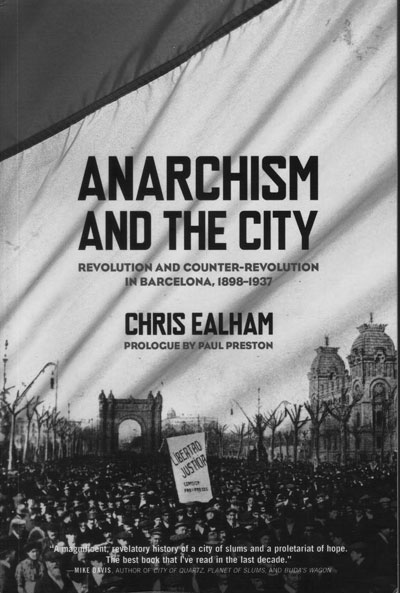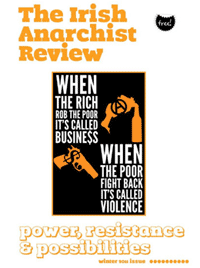Over 30 years of anarchist writing from Ireland listed under hundreds of topics
Revolution & Counter Revolution in Barcelona
Date: Wed, 2011-10-19 15:57
 Seventy-five years ago, in Barcelona and across much of the rest of Spain, anarchists and other radical workers, in order to stop Franco’s attempted coup, stormed army barracks, took over the factories and kicked off “the greatest revolutionary festival in the history of contemporary Europe.”(p.173). A familiar story no doubt, however, unlike many ostensible working class histories of the period, that are often just histories of workers’ organisations, Ealham’s engaging writing and theoretical fluency give us a complete view of proletarian life, from community centres in the city’s slums, to unemployed groups of shoplifters, to general strikes and uprisings.
Seventy-five years ago, in Barcelona and across much of the rest of Spain, anarchists and other radical workers, in order to stop Franco’s attempted coup, stormed army barracks, took over the factories and kicked off “the greatest revolutionary festival in the history of contemporary Europe.”(p.173). A familiar story no doubt, however, unlike many ostensible working class histories of the period, that are often just histories of workers’ organisations, Ealham’s engaging writing and theoretical fluency give us a complete view of proletarian life, from community centres in the city’s slums, to unemployed groups of shoplifters, to general strikes and uprisings.
The book starts with the growth of Barcelona due to its industrialisation from the 1850s onwards. As the newly formed proletariat were housed in slum-like barris without social services, an “anarchist-inspired workers’ public sphere” (p.34) began to develop. This consisted of community cultural and social centres (called ateneus in Catalan) of which 75 were formed in Barcelona between 1877 and 1914. These were the heartbeat of working class life and where theatre, choral, Esperanto, hiking, naturist, sports and musical groups would meet.
A vibrant culture of debate and discussion in the ateneus was kept alive with libraries that contained “a broad selection of the classics of European post-Enlightenment political and literary writing, ranging from Marx and Bakunin across to radical bourgeois writers such as Ibsen and Zola.”(p.45). Co-operative run shops, crèches and cafés, brought basic needs within the budget of working class families, as did the de-hierarchisised modern schools many ateneus also housed. In times of heightened class conflict the ateneus were often the victims of state repression. That the schools were viewed as particularly subversive could be evidenced when, after the Barcelona uprising of 1909, anarchist educational writer and teacher, Francisco Ferrer, was executed by the state even though he played no part in the rebellion.
Out of the failed uprising grew the anarchist trade union, the CNT. Their militant strikes and revolutionary agitation won Spain the eight hour day before any other country in Europe. However the organised and radicalised working class precipitated a state backlash that culminated in a military coup in 1923. The ateneus proved vital in keeping anarchist ideas alive during the period of the dictatorship, when the CNT was illegal and other trade unions state controlled.
Not only were workers organised by the CNT, so too were the unemployed; and their often ignored political activity makes for great reading. Coming from such a class conscious proletariat, the unemployed suffered no moral judgements for robbing from the bourgeoisie to secure what they called their right to life. ‘Eating by force’, as not paying in restaurants was referred to, and group raids of shops, were also common.
The culture of proletarian self-empowerment was such that when a beggar once asked the now (in)famous anarchist Durruti for some change, he responded by handing him a gun, giving the advice: “Take it! Go to a bank if you want money!” (p.126). Ealham points out the normative dimension to the crime of the unemployed: the bourgeoisie were exclusively the victims of it; intra-class proletarian crime was virtually non-existent.
With the barris being no-go areas for the bourgeoisie and the police, the mainstream press ran stories intended to provoke a moral panic about working class life. Readers heard of the innocent youth being exposed to anarchist orgies while on hiking trips and of the dangerous TB gangs who roamed the streets. The working class port area of the Raval, where there were many bars, cabarets and dance halls as well as a large population of single, unskilled, migrant labourers living in cheap hostels, was renamed ‘Chinatown’ (Barri xino), after inner-city Los Angeles.
The ‘foreign’ nature of the ‘bad’ working class was emphasised more and more with the rise of Catalan nationalism amongst the bourgeoisie (responded to by many Catalan anarchists by proudly identifying as Murcian). Not coincidentally this followed Spain’s loss of its last overseas colonies in 1898 and the economic disaster it provoked, as the industrialists of the country, mostly concentrated in Catalonia, lost their access to lucrative protected overseas markets.
The drop in the profit margins that followed, as well as the subsidising of a backward looking Madrid central government, meant Catalonia could not afford a welfare state to calm working class discontent. We therefore see, like in the early twenties, a spiral of mutual class radicalisation after the declaration of the Spanish Second Republic in 1931. In response to repression of the CNT, anarchists engaged in a series of failed insurrections and grupismo: a campaign of urban guerilla warfare involving bombings, bank robberies and killing some strike-breakers and particularly nasty employers.
The needs of the radicalised Barcelona working class could simply not be met by 1930s capitalism. That this would be a hard job for capital under any conditions could be seen as early as the night of the 1931 declaration when, refusing to wait for the republicans to fulfil their election promise, CNT members successfully stormed the local jail to release political prisoners and burn records.
Ealham gives an exciting account of the army’s attempted coup and the revolution it provoked. However be warned, while reading the great stories from a Barcelona now in working class control, many anarchists may also feel the need to shout ‘idiots!’ several times at our CNT comrades who made some terrible mistakes which led to the “definitive eradication of revolutionary power” (p.193) after May ‘37.
Throughout the book Ealham doesn’t fail to criticise the Barcelona anarchists when necessary – for example, for the exclusion of women from most ateneus activities, and for the negative effects of grupismo and the cycle of insurrections – however, when the revolution’s premature ending is critiqued his analysis could go deeper. The anarchists’ defeat is not critically related to their understanding, or, as I would see it, misunderstanding, of anarchism – this is all the more surprising given that Ealham competently, and quite accessibly, relates lots of the rest of the history to theoretical frameworks, participants’ consciousness of these, and how this effected group behaviour.
Mike Davis, a Marxist I believe, calls Anarchism and the City the best book he has read in a decade. I’d come very close to concurring; it certainly does stand out as a fantastic example of how working class history should be written. Instead of presenting an alphabet soup of trade unions and political organisations or, as other histories from below sometimes do, losing sight of the bigger picture in masses of stories from ordinary people’s lives, Ealham gives us a gripping historical sociology of a city going through some of its most revolutionary years – a complete portrayal of working class life in that place, at that time. That is real people’s history!
This article is from Irish Anarchist Review, Issue 4, October 2011


